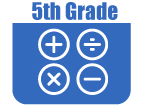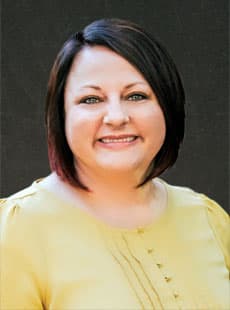
These resources are intended for review and practice after initial instruction of the standards.

- IXL Game: Algebra: Write equations to represent word problems
This game will help fifth graders write equations to represent word problems. This is just one of many online games that supports the Utah Math core. Note: The IXL site requires subscription for unlimited use. - Order of Operations
Arithmetic operations where there are no parentheses are the focus of this video as students learn about the order of operations. Note: You have to create a Free PBS Account to view this web page, but it is easy to do and worth the effort. - Order of Operations: PEMDAS
A Flocabulary rap song instructs students on the order of operations and then they apply that knowledge to the classroom activity. NOTE: You have to create a Free PBS Account to view this web page, but it is easy to do and worth the effort.
- Finding Patterns to Make Predictions
This activity asks students to identify and contemplate mathematical patterns that we see around us. They are asked to represent them in a table and predict the pattern to the 7th, 9th, and nth terms. NOTE: You have to create a Free PBS Account to view this web page, but it is easy to do and worth the effort. - Patterns in Pascal's Triangle
This lesson is designed to show students that patterns exist in the Pascal's Triangle, and to reinforce student's ability to identify patterns. - Petals Around the Rose
This lesson plan involves the playing of a dice game in which students must use problem-solving skills in order to discover the non-standard pattern in the dice rolls.

- Base 60: Babylonian Decimals
An Annenberg Learning Math video introduces students to the Babylonian number system in base 60. In the classroom activity they review base 10 and apply their understanding to write numbers in base 60. NOTE: You have to create a Free PBS Account to view this web page, but it is easy to do and worth the effort.
- Determining Surface Area with Unit Blocks, Rulers, and Nets
In this video students are shown how to calculate the surface area of a prism. The classroom activity in the lesson requires that students apply this knowledge and measure the surface areas of real 3-Dl objects. NOTE: You have to create a Free PBS Account to view this web page, but it is easy to do and worth the effort. - IXL Game: Mixed Operations
This game will help fifth graders understand how to add, subtract, multiply, and divide decimals. This is just one of many online games that supports the Utah Math core. Note: The IXL site requires subscription for unlimited use.

- Commutative and Associative Equations
This lesson focuses on how to rearrange and combine parts of algebraic expressions by using the commutative and associative properties of addition. NOTE: You have to create a Free PBS Account to view this web page, but it is easy to do and worth the effort. - Fraction Facts
This lesson plan uses an online game to teach students how to perform the four basic operations on fractions. - Make Your Own Fractions Worksheet
This Teachers Corner page allows the teacher to create worksheets to give students practice with addition, subtraction, multiplication and division of fractions. - Subtraction of Fractions Using a Visual Model
Students will learn how to subtract fractions with unlike denominators by using a visual model. NOTE: You have to create a Free PBS Account to view this web page, but it is easy to do and worth the effort.
- Fraction Facts
This lesson plan uses an online game to teach students how to perform the four basic operations on fractions. - IXL Game: Mixed operations: fractions and mixed numbers
This game will help fifth graders understand how to add, subtract, multiply, and divide fractions and mixed numbers. This is just one of many online games that supports the Utah Math core. Note: The IXL site requires subscription for unlimited use. - Make Your Own Fractions Worksheet
This Teachers Corner page allows the teacher to create worksheets to give students practice with addition, subtraction, multiplication and division of fractions. - Modeling Fraction and Mixed Number Division Using Arrays
Students will learn how to solve word problems that involve dividing fractions and mixed numbers by using a visual model. NOTE: You have to create a Free PBS Account to view this web page, but it is easy to do and worth the effort. - Multiply Fractions Jeopardy
This game can be played by one or two players as they solve multiplication problems with fractions. - Product of a Whole Number and a Fraction
With the help of this video students will learn how to multiply a whole number and a fraction. A classroom activity involving money asks students practice this skill. NOTE: You have to create a Free PBS Account to view this web page, but it is easy to do and worth the effort.

- Geometry and Classification of 2D Figures: Bianca Busts a Move
After breaking a friend's table while dancing on it, Bianca must use her knowledge of measurement and geometry to get a piece of wood to fix it. In the classroom activity students create tabletop designs in order to use their knowledge of perimeter and area. NOTE: You have to create a Free PBS Account to view this web page, but it is easy to do and worth the effort. - IXL Game: Measurement: Convert customary units involving fractions
This game will help fifth graders understand how to convert customary units involving fractions. This is just one of many online games that supports the Utah Math core. Note: The IXL site requires subscription for unlimited use. - Living Wages in CA: Ratio and Rate in the Real World
The use of infographics helps us understand the costs of basic living expenses. The classroom activity has students look at real-life examples and data to calculate whether the minimum wage in their state can be a living wage. NOTE: You have to create a Free PBS Account to view this web page, but it is easy to do and worth the effort. - Standard Measures and Conversions within a System: Solve the Measurement Problem!
In this video a group of friends must follow a recipe to cure a friend. They must not only find standard measures to use but also make the dosage stronger. Students then use measuring tools to create a classroom conversion chart. NOTE: You have to create a Free PBS Account to view this web page, but it is easy to do and worth the effort. - Standard Measures and Conversions: Liquid Volume, Milliliters and Liters
These videos help students learn about measuring liquid volume and the units, milliliters and liters, used in the calculation. Students then demonstrate this understanding by creating a classroom conversion chart. NOTE: You have to create a Free PBS Account to view this web page, but it is easy to do and worth the effort.
- Histograms and Bar Graphs
This lesson will introduce students to histograms and bar graphs and help them understand the difference between them.
- Breaking Apart Composite Solids
The purpose of this task is to help students see different ways of breaking a solid into right rectangular prisms and to relate volume to the operations of multiplication and division. - Surface Area and Volume
An online activity is the focus of this lesson plan to help students understand the concepts of surface area and volume. - Understanding Concepts of Volume and Measurement: Bianca's Babysitting Blues
Bianca the babysitter has a dilemma, she has two differently shaped bottles to feed the twins. How can she determine the volume of them so that she can give the babies equal amounts of formula? NOTE: You have to create a Free PBS Account to view this web page, but it is easy to do and worth the effort.

- Battleship Using Grid Paper
The purpose of this task is to give students practice plotting points in the first quadrant of the coordinate plane and naming coordinates of points. It could be easily adapted to plotting points with negative coordinates. It also provides teachers with a good opportunity to assess how well their students understand how to plot ordered pairs and identify the coordinates of points. - Battleships - Example
Use this link as an example for "Battleship Using Grid Paper" activity. - Cartesian Coordinate System
This lesson is designed to help students understand the Cartesian plane, specifically how to plot points, read coordinates and find the ratio of the rise over run for slope. - Graphing Points on a Coordinate Plane: Harry's Feet Compete
This Cyberchase video follows Harry as he decides to get fit and establish a workout program. He charts his progress on a graph. The classroom activity consists of a ball-balancing game in which students graph their attempts. NOTE: You have to create a Free PBS Account to view this web page, but it is easy to do and worth the effort. - Hoop Dream: Use a Diagram to Solve Real-World Math Problems
Students learn about creating diagrams and plotting points on a plane by watching these short videos about kids playing a game involving making baskets. They then play a game where they plot points on a plane. NOTE: You have to create a Free PBS Account to view this web page, but it is easy to do and worth the effort. - Horizontal and Vertical Distances on the Cartesian Graph
In this activity students place marine animals on a Cartesian graph and then determine the horizontal and vertical distance between them. The classroom activity builds on the student's understanding of distances between points on a Cartesian graph. NOTE: You have to create a Free PBS Account to view this web page, but it is easy to do and worth the effort. - IXL Game: Graph points on a coordinate plane
This game is designed to help fifth graders learn to graph points on a coordinate plane. This is just one of many online games that supports the Utah Math core. Note: The IXL site requires subscription for unlimited use. - Locating Points on the Cartesian Graph
In this activity students use logic and clues to plot the location of marine animals on a Cartesian graph. NOTE: You have to create a Free PBS Account to view this web page, but it is easy to do and worth the effort. - Maze Game
In this applet students move a robot through a mine field by using coordinates on the Cartesian Plane in order to remove the land mines.
- An Introduction To Quadrilaterals
In this lesson the student is introduced to parallelograms, rectangles, and trapezoids and practices creating various types of quadrilaterals. - Classifying Quadrilaterals
This video teaches students strategies to identify the properties of quadrilaterals. The emphasis is on parallelograms. Students create posters explaining the properties of quadrilaterals in the classroom activity. NOTE: You have to create a Free PBS Account to view this web page, but it is easy to do and worth the effort. - Classifying Triangles by Angles and Sides
A middle-school student named Julia explains the classification of triangles by the use of angle measurements and side lengths in this introductory video. Students then take their understanding and use it in a scavenger hunt around the classroom finding triangles of different types. NOTE: You have to create a Free PBS Account to view this web page, but it is easy to do and worth the effort. - Geometry and Classification of 2D Figures: Bianca Busts a Move
After breaking a friend's table while dancing on it, Bianca must use her knowledge of measurement and geometry to get a piece of wood to fix it. In the classroom activity students create tabletop designs in order to use their knowledge of perimeter and area. NOTE: You have to create a Free PBS Account to view this web page, but it is easy to do and worth the effort. - Tessellate!
This lesson and activity will help the student understand how to classify two-dimensional figures based on properties. The student manipulates shapes to create now polygons.

![]()
![]() The Online Core Resource pages are a collaborative project between the Utah State Board of Education and the Utah Education Network. If you would like to recommend a high quality resource, contact Trish French (Elementary) or Lindsey Henderson (Secondary). If you find inaccuracies or broken links contact resources@uen.org.
The Online Core Resource pages are a collaborative project between the Utah State Board of Education and the Utah Education Network. If you would like to recommend a high quality resource, contact Trish French (Elementary) or Lindsey Henderson (Secondary). If you find inaccuracies or broken links contact resources@uen.org.


 UTAH EDUCATION NETWORK
UTAH EDUCATION NETWORK

 Justin
Justin Braxton
Braxton Dani
Dani Kayla
Kayla Katie
Katie Matthew
Matthew Rob
Rob Val
Val





